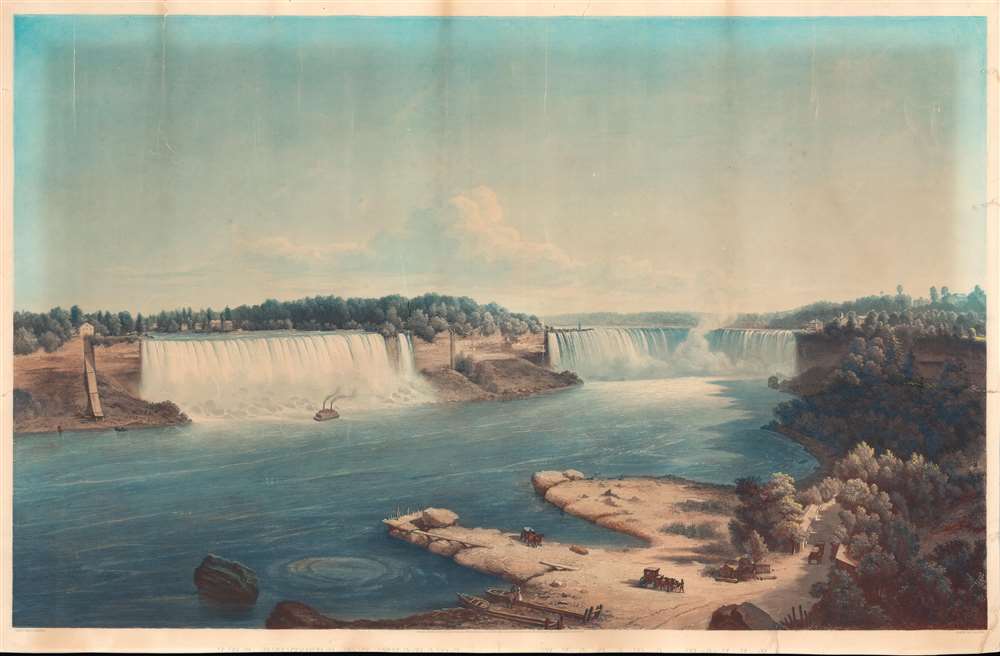Digital Image: 1852 Sebron and Salathe Aquatint View of Niagara Falls General View
NiagaraFallsGeneral-sebron-1852_d
Title
1852 (dated) 26 x 38 in (66.04 x 96.52 cm)
Description
FOR THE ORIGINAL ANTIQUE MAP, WITH HISTORICAL ANALYSIS, CLICK HERE.
Digital Map Information
Geographicus maintains an archive of high-resolution rare map scans. We scan our maps at 300 DPI or higher, with newer images being 600 DPI, (either TIFF or JPEG, depending on when the scan was done) which is most cases in suitable for enlargement and printing.
Delivery
Once you purchase our digital scan service, you will receive a download link via email - usually within seconds. Digital orders are delivered as ZIP files, an industry standard file compression protocol that any computer should be able to unpack. Some of our files are very large, and can take some time to download. Most files are saved into your computer's 'Downloads' folder. All delivery is electronic. No physical product is shipped.
Credit and Scope of Use
You can use your digial image any way you want! Our digital images are unrestricted by copyright and can be used, modified, and published freely. The textual description that accompanies the original antique map is not included in the sale of digital images and remains protected by copyright. That said, we put significant care and effort into scanning and editing these maps, and we’d appreciate a credit when possible. Should you wish to credit us, please use the following credit line:
Courtesy of Geographicus Rare Antique Maps (https://www.geographicus.com).
How Large Can I Print?
In general, at 300 DPI, you should at least be able to double the size of the actual image, more so with our 600 DPI images. So, if the original was 10 x 12 inches, you can print at 20 x 24 inches, without quality loss. If your display requirements can accommodate some loss in image quality, you can make it even larger. That being said, no quality of scan will allow you to blow up at 10 x 12 inch map to wall size without significant quality loss. For more information, it is best consult a printer or reprographics specialist.
Refunds
If the high resolution image you ordered is unavailable, we will fully refund your purchase. Otherwise, digital images scans are a service, not a tangible product, and cannot be returned or refunded once the download link is used.
Cartographer S
Hippolyte Victor Valentin Sébron (August 21, 1801 - September 1, 1879) was a French painter active throughout Europe, Asia, and the United States in the middle part of the 19th century. Sébron was born in Caudebec-en-Caux in the Seine-Maritime. Sébron is best known for his landscapes and dioramas, but his full corpus includes portraits, architectural views, and interior scenes as well. He was a regular exhibitor at the famed Paris Salon, as well as at the London Royal Bazaar, and at the New York National Academy of Design. Sébron also worked closely with Louis-Jacques-Mandé Daguerre, inventory of the daguerreotype. Working together Sébron and Daguerre created several artworks wherein they employed innovating lighting and painting techniques to produce unique effects that seems to transition between night and day. After a long prosperous career and a life of world travel, Sébron died in Paris in 1879 at the age of 78. More by this mapmaker...
Friedrich Salathé (January 11, 1793 - May 12, 1858) was Swiss graphic artist, engraver, draftsman, and aquafortist. Salathé was born in Binningen, Switzerland, the son of the farmer Jospeh Salathé. He apprenticed with the Swiss painter Peter Birmann. He lived for a time in Italy serving on the Pope's Swiss Guard. While in Italy he developed as an artist exhibiting in Rome in 1919. He subsequently returned to Binningen, near Basel, in 1821, taking work with the print sellers Falkeisen and Huber. Reaching the age of 30 in 1823 he relocated, permanently, to Paris, which his work was generally admired. There too he met and married the artist Friederike Neuhaus. Salathé exhibited throughout Paris and two of his aquatints were exhibited at the Paris Salon of 1841. He also worked with Johann Jacob Steinmann producing lithographic and photographic prints. Salathé is best known for his landscapes. Learn More...

